Simultaneous Dual-mode Emission and Tunable Multicolor in the Time Domain from Lanthanide-doped Core-shell Microcrystals
Abstract
1. Introduction
2. Materials and Methods
2.1. Materials
2.2. Preparation of β-NaYF4:Yb/Er Microrods
2.3. Preparation of Seeding Microrods
2.4. Sequential of Core-Shell-Structured Microrods
2.5. Characterization
3. Results and Discussion
4. Conclusions
Supplementary Materials
Author Contributions
Acknowledgments
Conflicts of Interest
References
- Liu, Y.; Tu, D.; Zhu, H.; Li, R.; Luo, W.; Chen, X. A strategy to achieve efficient dual-mode luminescence of Eu3+ in lanthanides doped multifunctional NaGdF4 nanocrystals. Adv. Mater. 2010, 22, 3266–3271. [Google Scholar] [CrossRef] [PubMed]
- Han, Y.; Gao, C.; Wang, Y.; Ju, D.; Zhou, A.; Song, F.; Huang, L.; Huang, W. Spatially confined luminescence process in tip-modified heterogeneous-structured microrods for high-level anti-counterfeiting. Phys. Chem. Chem. Phys. 2018, 20, 9516–9522. [Google Scholar] [CrossRef] [PubMed]
- Wen, S.; Zhou, J.; Zheng, K.; Bednarkiewicz, A.; Liu, X.; Jin, D. Advances in highly doped upconversion nanoparticles. Nat. Commun. 2018, 9, 2415. [Google Scholar] [CrossRef] [PubMed]
- Wang, F.; Han, Y.; Lim, S.C.; Lu, Y.H.; Wang, J.; Xu, J.; Chen, H.Y.; Zhang, C.; Hong, M.H.; Liu, X.G. Simultaneous phase and size control of upconversion nanocrystals through lanthanide doping. Nature 2010, 463, 1060–1065. [Google Scholar] [CrossRef] [PubMed]
- Richards, B.S. Luminescent layers for enhanced silicon solar cell performance: Down-conversion. Solar Energy Mater. Solar Cells 2006, 90, 1189–1207. [Google Scholar] [CrossRef]
- Zheng, K.; Han, S.; Zeng, X.; Wu, Y.; Song, S.; Zhang, H.; Liu, X. Rewritable optical memory through high-registry orthogonal upconversion. Adv. Mater. 2018, 30, 1801726. [Google Scholar] [CrossRef] [PubMed]
- Gu, M.; Zhang, Q.; Lamon, S. Nanomaterials for optical data storage. Nat. Rev. Mater. 2016, 1, 16070. [Google Scholar] [CrossRef]
- Lei, L.; Chen, D.; Li, C.; Huang, F.; Zhang, J.; Xu, S. Inverse thermal quenching effect in lanthanide-doped upconversion nanocrystals for anti-counterfeiting. J. Mater. Chem. C 2018, 6, 5427–5433. [Google Scholar] [CrossRef]
- Wang, H.; Yin, X.; Xing, M.; Fu, Y.; Tian, Y.; Feng, X.; Jiang, T.; Luo, X. Thermal effects of Er3+/Yb3+-doped NaYF4 phosphor induced by 980/1510 nm laser diode irradiation. J. Am. Ceram. Soc. 2018, 101, 865–873. [Google Scholar] [CrossRef]
- Zhou, A.; Song, F.; Han, Y.; Song, F.F.; Ju, D.; Wang, X. Simultaneous size adjustment and upconversion luminescence enhancement of β-NaLuF4:Yb3+/Er3+,Er3+/Tm3+ microcrystals by introducing Ca2+ for temperature sensing. CrystEngComm 2018, 20, 2029–2035. [Google Scholar] [CrossRef]
- Sakr, H.; Tang, Z.; Furniss, D.; Sojka, L.; Sujecki, S.; Benson, T.M.; Seddon, A.B. Promising emission behavior in Pr3+/In selenide-chalcogenide-glass small-core step index fiber (SIF). Opt. Mater. 2017, 67, 98–107. [Google Scholar] [CrossRef]
- Wang, T.; Yu, H.; Siu, C.K.; Qiu, J.; Xu, X.; Yu, S.F. White-light whispering-gallery-mode lasing from lanthanide-doped upconversion NaYF4 hexagonal microrods. ACS Photon. 2017, 4, 1539–1543. [Google Scholar] [CrossRef]
- Chen, Q.; Xie, X.; Huang, B.; Liang, L.; Han, S.; Yi, Z.; Wang, Y.; Li, Y.; Fan, D.; Huang, L.; et al. Confining excitation energy in Er3+-sensitized upconversion nanocrystals through Tm3+-mediated transient energy trapping. Angew. Chem. Int. Ed. Engl. 2017, 56, 7605–7609. [Google Scholar] [CrossRef] [PubMed]
- Wu, X.; Zhang, Y.; Takle, K.; Bilsel, O.; Li, Z.; Lee, H.; Zhang, Z.; Li, D.; Fan, W.; Duan, C.; et al. Dye-sensitized core/active shell upconversion nanoparticles for optogenetics and bioimaging applications. ACS Nano 2016, 10, 1060–1066. [Google Scholar] [CrossRef] [PubMed]
- Dong, H.; Sun, L.D.; Feng, W.; Gu, Y.; Li, F.; Yan, C.H. Versatile spectral and lifetime multiplexing nanoplatform with excitation orthogonalized upconversion luminescence. ACS Nano 2017, 11, 3289–3297. [Google Scholar] [CrossRef] [PubMed]
- Zhuo, Z.; Liu, Y.; Liu, D.; Huang, P.; Jiang, F.; Chen, X.; Hong, M. Manipulating energy transfer in lanthanide-doped single nanoparticles for highly enhanced upconverting luminescence. Chem. Sci. 2017, 8, 5050–5056. [Google Scholar] [CrossRef]
- Zhang, Y.; Zhang, L.; Deng, R.; Tian, J.; Zong, Y.; Jin, D.; Liu, X. Multicolor barcoding in a single upconversion crystal. J. Am. Chem. Soc. 2014, 136, 4893–4896. [Google Scholar] [CrossRef]
- Zhang, Y.; Huang, L.; Liu, X. Unraveling epitaxial habits in the NaLnF4 system for color multiplexing at the single-particle level. Angew. Chem. Int. Ed. 2016, 55, 1–6. [Google Scholar] [CrossRef]
- Back, M.; Marin, R.; Franceschin, M.; Sfar Hancha, N.; Enrichi, F.; Trave, E.; Polizzi, S. Energy transfer in color-tunable water-dispersible Tb–Eu codoped CaF2 nanocrystals. J. Mater. Chem. C 2016, 4, 1906–1913. [Google Scholar] [CrossRef]
- Lai, J.; Zhang, N.; Pasquale, N.; Lee, K. An upconversion nanoparticle with orthogonal emissions using dual NIR excitations for controlled two-way photoswitching. Angew. Chem. Int. Ed. Engl. 2014, 53, 14419–14423. [Google Scholar] [CrossRef]
- Zhang, X.; Zhou, L.; Pang, Q.; Shi, J.; Gong, M. Tunable Luminescence and Ce3+→ Tb3+→ Eu3+ energy transfer of broadband-excited and narrow line red emitting Y2SiO5:Ce3+, Tb3+, Eu3+ phosphor. J. Phys. Chem. C 2014, 118, 7591–7598. [Google Scholar] [CrossRef]
- Liu, J.; Rijckaert, H.; Zeng, M.; Haustraete, K.; Laforce, B.; Vincze, L.; Driessche, I.V.; Kaczmarek, A.M.; Deun, R.V. Simultaneously excited downshifting/upconversion luminescence from lanthanide-doped core/shell fluoride nanoparticles for multimode anticounterfeiting. Adv. Funct. Mater. 2018, 1707365. [Google Scholar] [CrossRef]
- Chen, B.; Kong, W.; Liu, Y.; Lu, Y.; Li, M.; Qiao, X.; Fan, X.; Wang, F. Crystalline hollow microrods for site-selective enhancement of nonlinear photoluminescence. Angew. Chem. Int. Ed. Engl. 2017, 56, 10383–10387. [Google Scholar] [CrossRef] [PubMed]
- Wang, F.; Liu, X. Recent advances in the chemistry of lanthanide-doped upconversion nanocrystals. Chem. Soc. Rev. 2009, 38, 976–989. [Google Scholar] [CrossRef] [PubMed]
- Podhorodecki, A.; Banski, M.; Misiewicz, J.; Afzaal, M.; O’Brien, P.; Chad, D.; Wang, X. Multicolor light emitters based on energy exchange between Tb and Eu ions co-doped into ultrasmall β-NaYF4 nanocrystals. J. Mater. Chem. 2012, 22, 5356. [Google Scholar] [CrossRef]
- Kim, S.Y.; Woo, K.; Lim, K.; Lee, K.; Jang, H.S. Highly bright multicolor tunable ultrasmall β-Na(Y,Gd)F4:Ce,Tb,Eu/β-NaYF4 core/shell nanocrystals. Nanoscale 2013, 5, 9255–9263. [Google Scholar] [CrossRef] [PubMed]
- Li, R.; Xiong, H.; Liang, Y.; Liu, Y.; Zhang, N.; Gan, S. Rapid, morphology-controllable synthesis of GdOF:Ln3+ (Ln = Eu, Tb) crystals with multicolor-tunable luminescence properties. New J. Chem. 2016, 40, 1792–1798. [Google Scholar] [CrossRef]
- Li, R.; Li, L.; Liang, Y.; Zhang, N.; Liu, Y.; Gan, S. A novel synthetic route towards monodisperse LaOF:Ln3+ (Ln = Eu, Tb) hollow spheres with multicolor luminescence properties. Phys. Chem. Chem. Phys. 2015, 17, 21485–21491. [Google Scholar] [CrossRef] [PubMed]
- Luo, Y.; Yang, R.; Zhang, X.; Hu, B.; Hu, S.; Zhou, L.; Yang, J. Shape-controllable hydrothermal synthesis of NaTbF4:Eu3+ microcrystals with energy transfer from Tb to Eu and multicolor luminescence properties. CrystEngComm 2015, 17, 7762–7771. [Google Scholar] [CrossRef]
- Wang, F.; Liu, X. Multicolor tuning of lanthanide-doped nanoparticles by single wavelength excitation. Acc. Chem. Res. 2014, 47, 1378–1385. [Google Scholar] [CrossRef] [PubMed]
- Chen, G.; Ågren, H.; Ohulchanskyy, T.Y.; Prasad, P.N. Light upconverting core-shell nanostructures: nanophotonic control for emerging applications. Chem. Soc. Rev. 2015, 44, 1680–1713. [Google Scholar] [CrossRef] [PubMed]
- Ju, D.; Song, F.; Han, Y.; Cui, W.; Zhou, A.; Liu, S.; Wang, X.; Feng, M.; Ming, C. Sequential growth of uniform β-NaYF4@β-NaLnF4 (Ln = Y, Lu, Yb) microcrystals with luminescent properties of multicolor tuning and dual-mode emission. Nanomaterials 2017, 7, 448. [Google Scholar] [CrossRef] [PubMed]
- Liu, X.; Deng, R.; Zhang, Y.; Wang, Y.; Chang, H.; Huang, L.; Liu, X. Probing the nature of upconversion nanocrystals: instrumentation matters. Chem. Soc. Rev. 2015, 44, 1479. [Google Scholar] [CrossRef] [PubMed]
- Podhorodecki, A.; Banski, M.; Noculak, A.; Sojka, B.; Pawlik, G.; Misiewicz, J. On the nature of carrier relaxation and ion-ion interactions in ultrasmall β-NaYF4:Eu3+ nanocrystals effect of the surface. Nanoscale 2013, 5, 429–436. [Google Scholar] [CrossRef] [PubMed]
- Tang, J.; Chen, L.; Li, J.; Wang, Z.; Zhang, J.; Zhang, L.; Luo, Y.; Wang, X. Selectively enhanced red upconversion luminescence and phase/size manipulation via Fe3+ doping in NaYF4:Yb,Er nanocrystals. Nanoscale 2015, 7, 14752–14759. [Google Scholar] [CrossRef] [PubMed]
- Wang, Y.; Tu, L.; Zhao, J.; Sun, Y.; Kong, X.; Zhang, H. Upconversion luminescence of β-NaYF4:Yb3+,Er3+@β-NaYF4 core/shell nanoparticles: excitation power density and surface dependence. J. Phys. Chem. C 2009, 113, 7164–7169. [Google Scholar] [CrossRef]
- Zuo, J.; Sun, D.; Tu, L.; Wu, Y.; Cao, Y.; Xue, B.; Zhang, Y.; Chang, Y.; Liu, X.; Kong, X.; et al. Precisely tailoring upconversion dynamicsvia energy migration in core–shell nanostructures. Angew. Chem. 2018, 130, 3108–3112. [Google Scholar] [CrossRef]
- Du, S.; Wang, D.; Qiang, Q.; Ma, X.; Tang, Z.; Wang, Y. The dual-model up/down-conversion green luminescence of Gd6O5F8:Yb3+,Ho3+,Li+ and its application for temperature sensing. J. Mater. Chem. C 2016, 4, 7148–7155. [Google Scholar] [CrossRef]
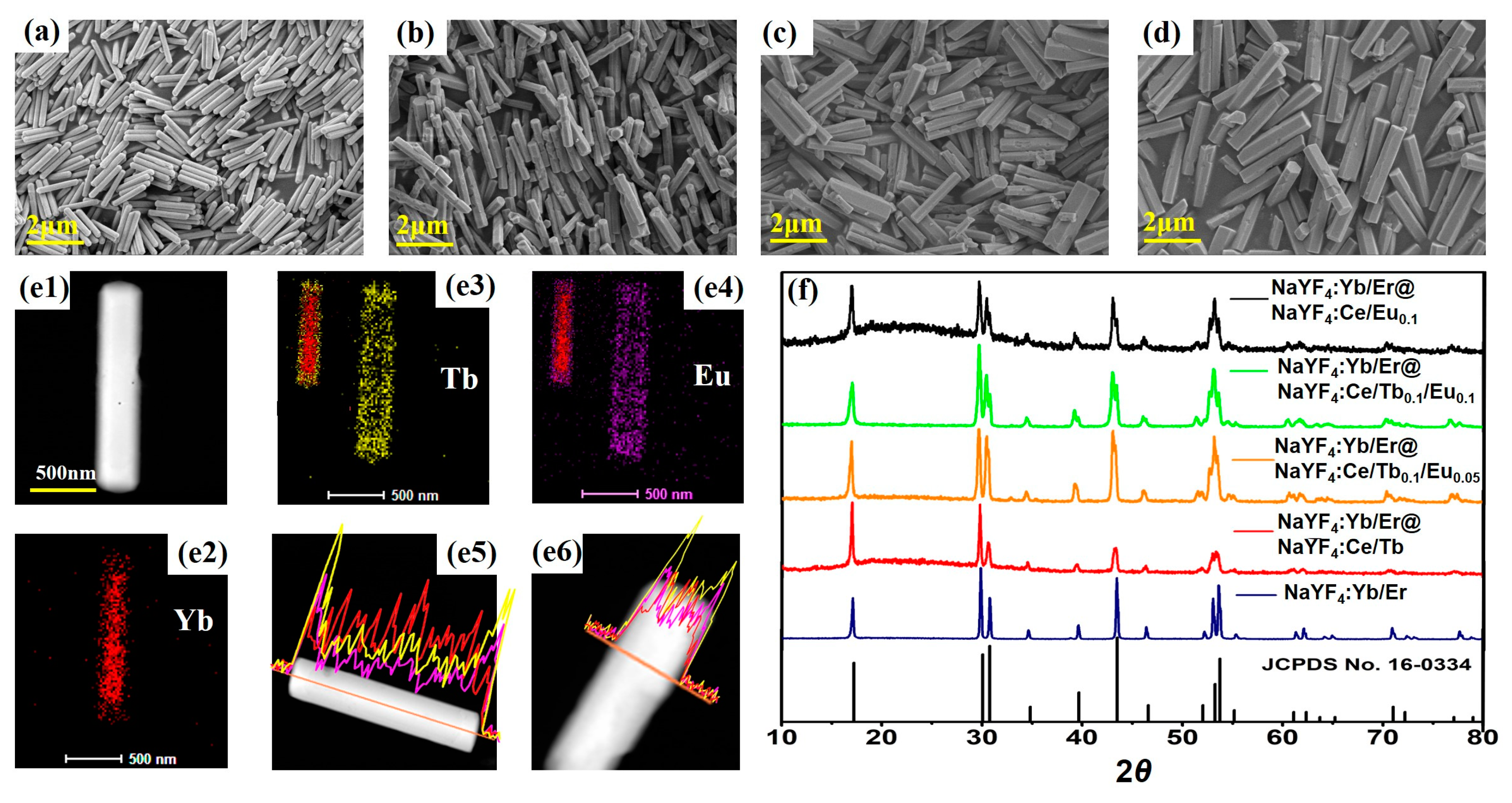
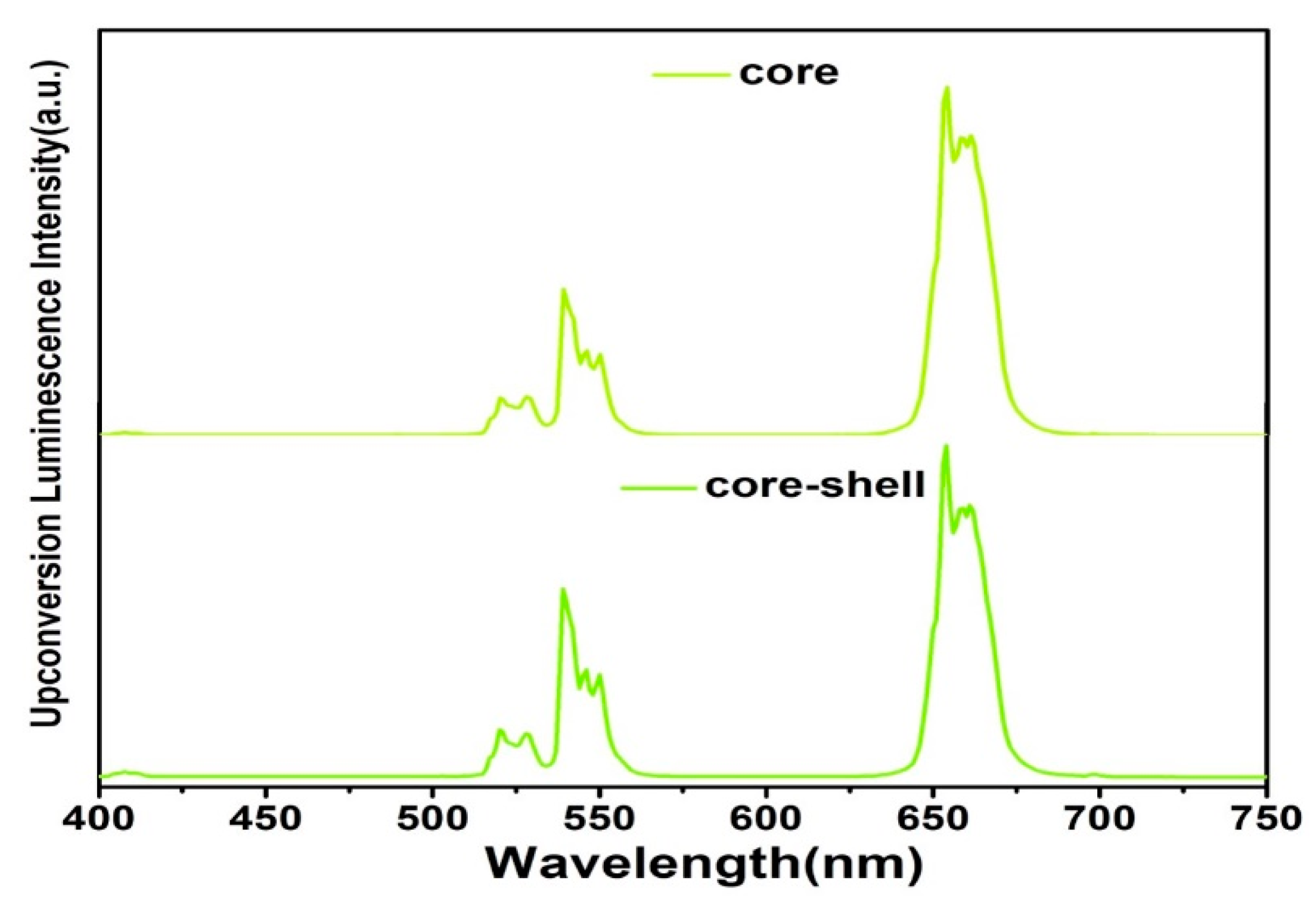
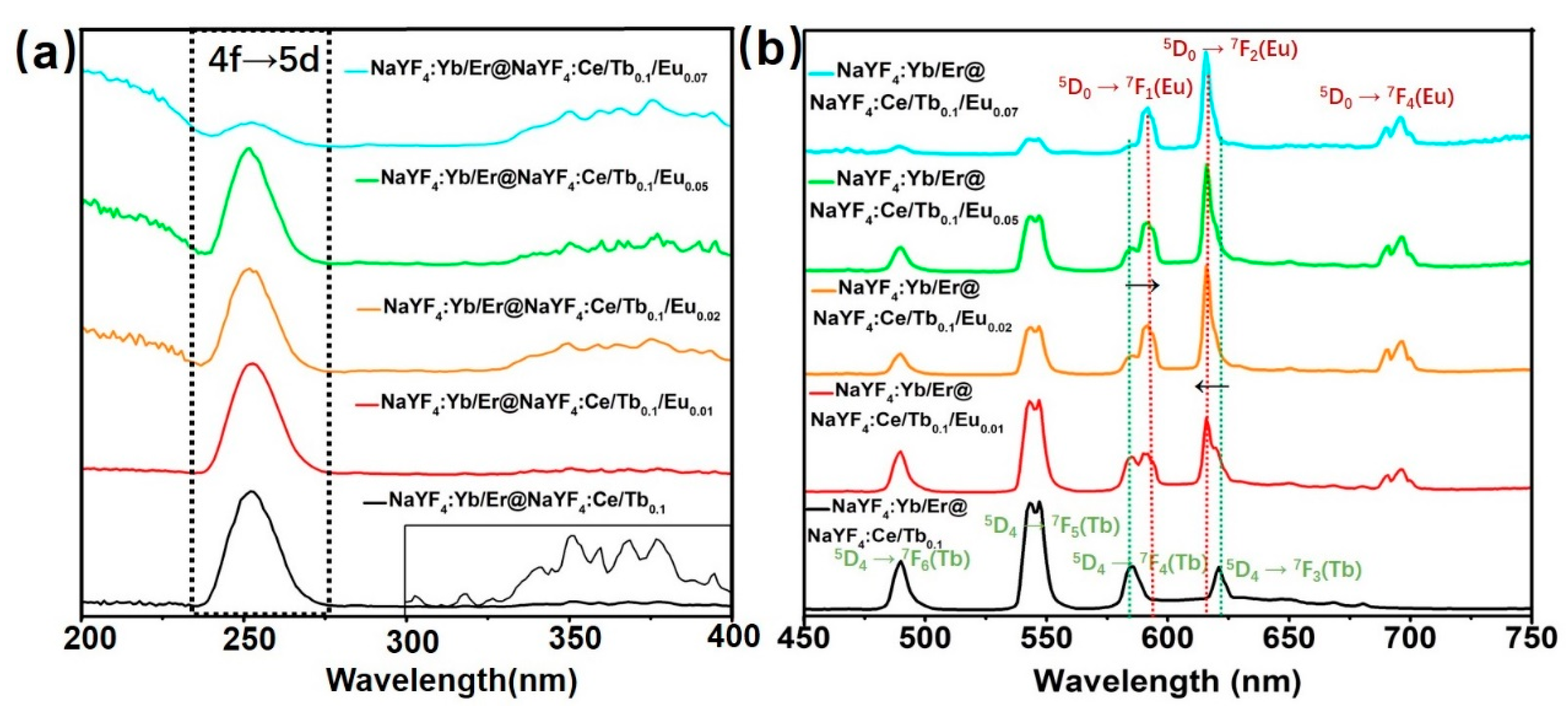
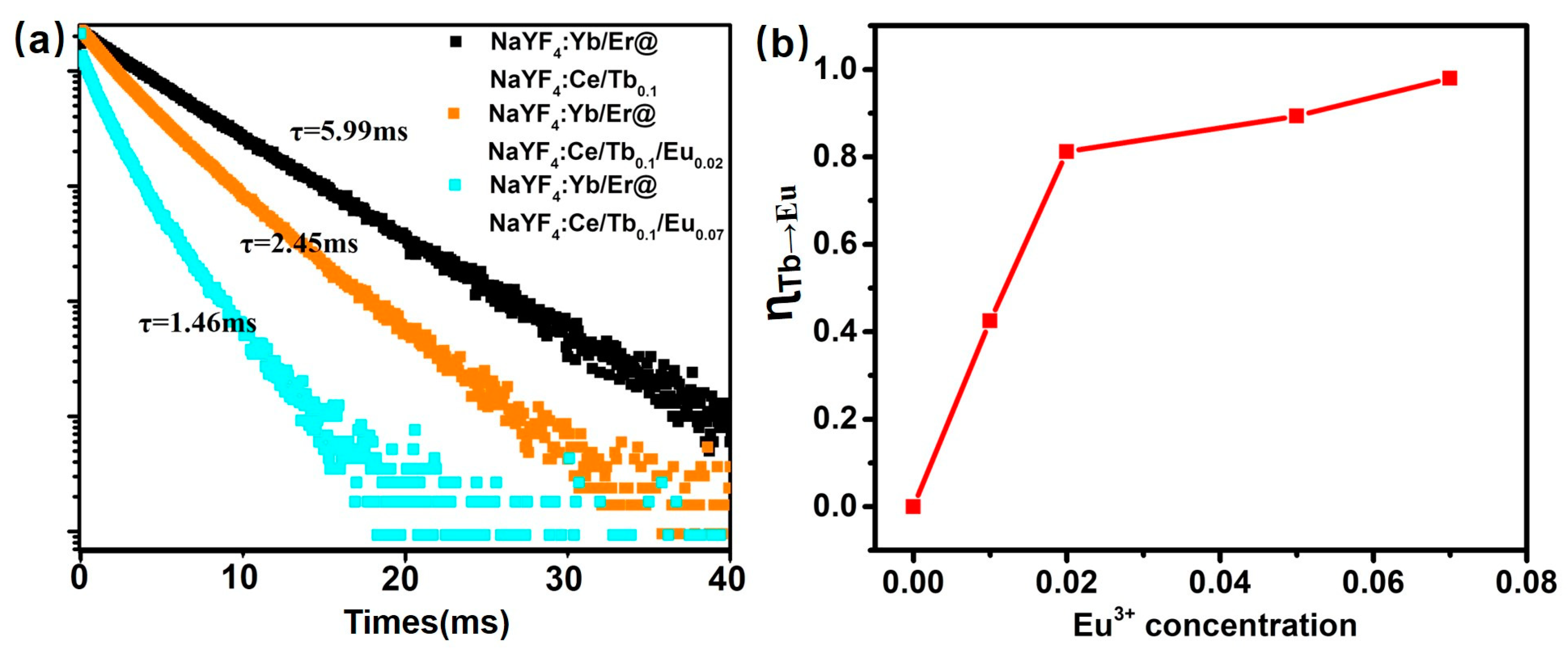
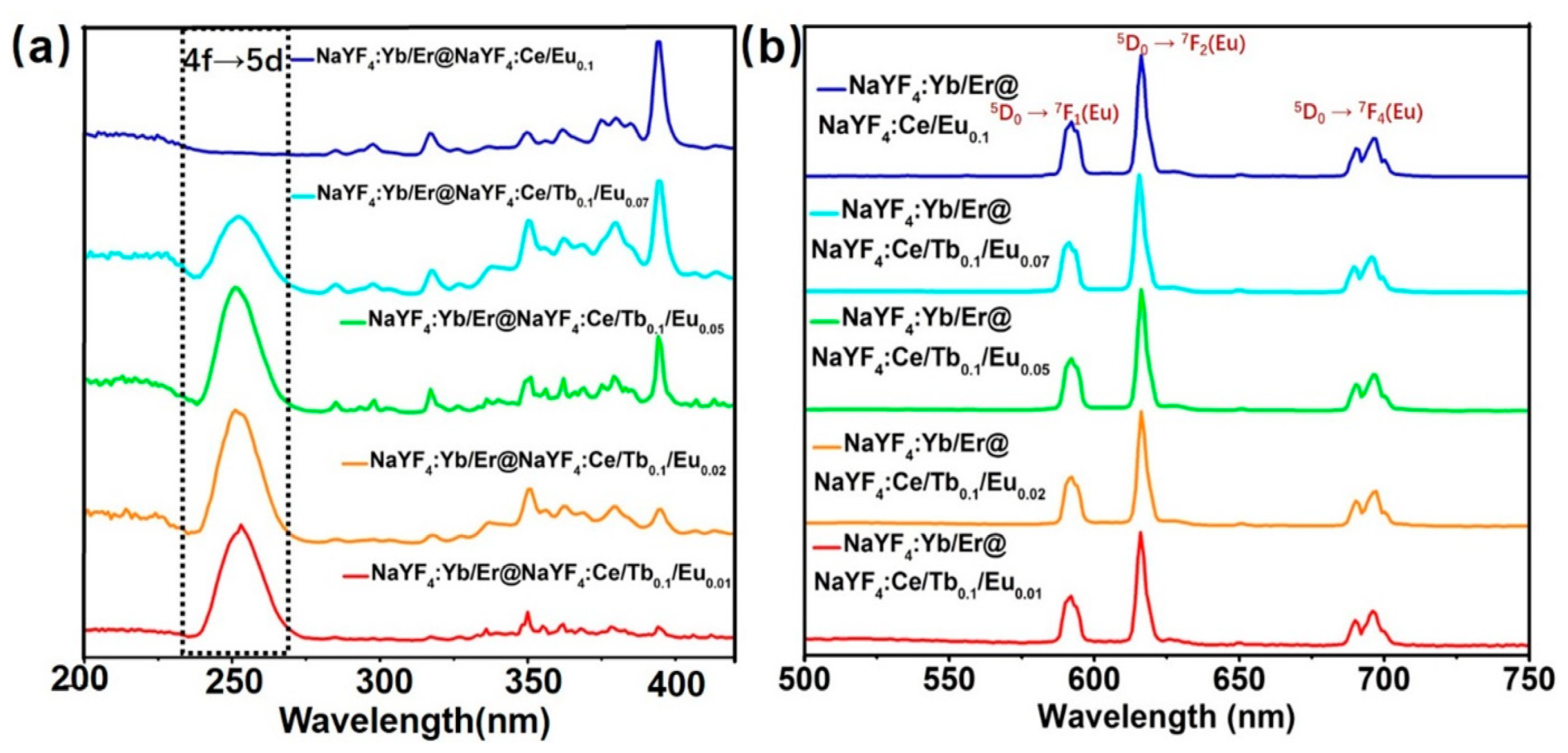
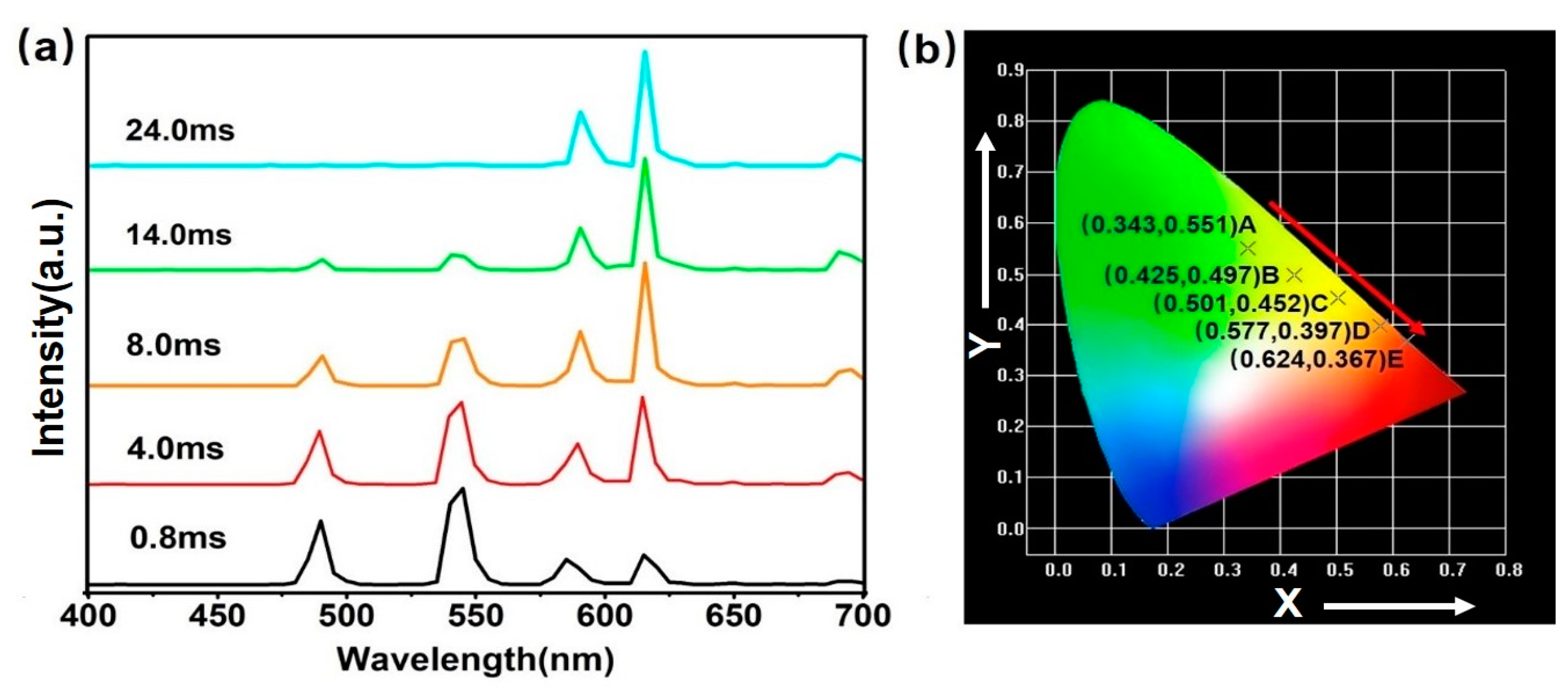
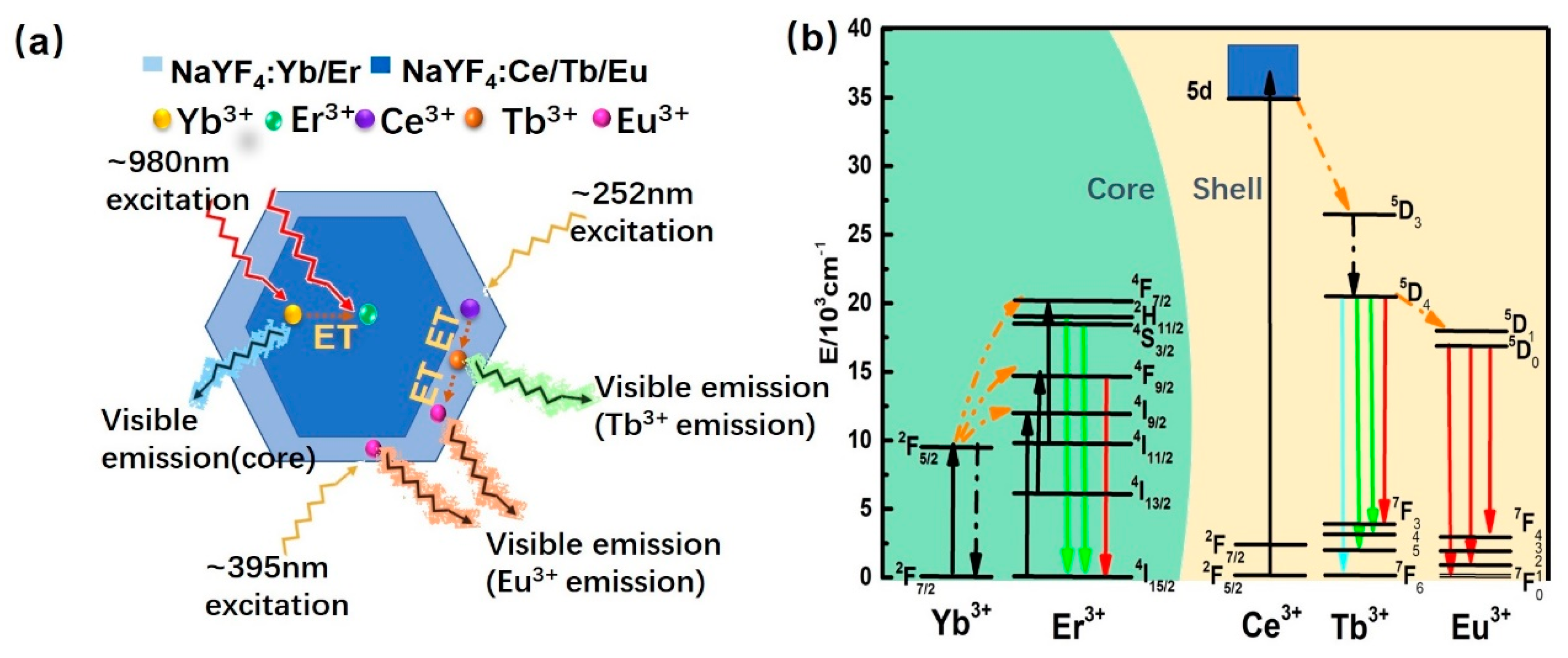
© 2018 by the authors. Licensee MDPI, Basel, Switzerland. This article is an open access article distributed under the terms and conditions of the Creative Commons Attribution (CC BY) license (http://creativecommons.org/licenses/by/4.0/).
Share and Cite
Ju, D.; Song, F.; Khan, A.; Song, F.; Zhou, A.; Gao, X.; Hu, H.; Sang, X.; Zadkov, V. Simultaneous Dual-mode Emission and Tunable Multicolor in the Time Domain from Lanthanide-doped Core-shell Microcrystals. Nanomaterials 2018, 8, 1023. https://doi.org/10.3390/nano8121023
Ju D, Song F, Khan A, Song F, Zhou A, Gao X, Hu H, Sang X, Zadkov V. Simultaneous Dual-mode Emission and Tunable Multicolor in the Time Domain from Lanthanide-doped Core-shell Microcrystals. Nanomaterials. 2018; 8(12):1023. https://doi.org/10.3390/nano8121023
Chicago/Turabian StyleJu, Dandan, Feng Song, Adnan Khan, Feifei Song, Aihua Zhou, Xiaoli Gao, Huimin Hu, Xu Sang, and Victor Zadkov. 2018. "Simultaneous Dual-mode Emission and Tunable Multicolor in the Time Domain from Lanthanide-doped Core-shell Microcrystals" Nanomaterials 8, no. 12: 1023. https://doi.org/10.3390/nano8121023
APA StyleJu, D., Song, F., Khan, A., Song, F., Zhou, A., Gao, X., Hu, H., Sang, X., & Zadkov, V. (2018). Simultaneous Dual-mode Emission and Tunable Multicolor in the Time Domain from Lanthanide-doped Core-shell Microcrystals. Nanomaterials, 8(12), 1023. https://doi.org/10.3390/nano8121023




